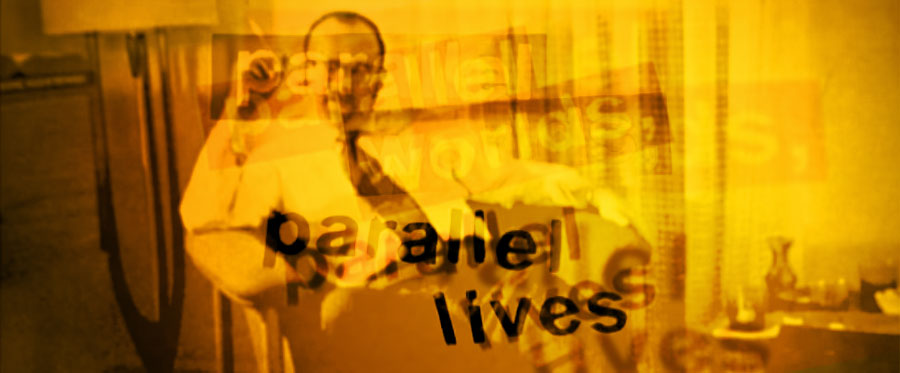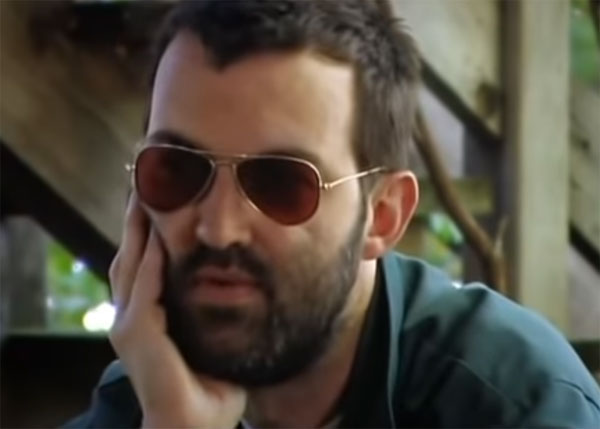It’s a dad, dad, dad, dad world. Eels frontman Mark Oliver Everett takes a rare quantum leap, losing himself in the strange world of his father, Quantum Mechanic, Hugh Everett III. Repeated Sunday 2nd December at 12.00am
26/11/2007

He’s everywhere and nowhere baby. That’s where he’s at. Going down the bumpy hillside in his hippy hat. But though he’s flying around the country, his tyres are never flat. Or rather in one dimension his tyres are flat and in the other he’s not flying around at all. He’s at home in California talking to his dog. In another he’s in Virginia, spinning around in a photon blur on a voyage of discovery, aggravating an infinite number of outcomes to an immensurable series of possible events. But that’s easy for me to say, isn’t it?
Bit of must-watch music TV for all those with fancy Freeview boxes and SKY digital on slick pop-art channel, BBC 4 Monday 26th November at 9.00pm.
Parallel Worlds, Parallel Lives follows the lead singer of US rock band Eels, Mark Oliver Everett, as he travels across America to learn about the father he lived with for 18 years but never really knew — the celebrated quantum physicist, Hugh Everett III.
This year is the 50th anniversary of Hugh Everett’s most important contribution to science — a controversial theory of quantum mechanics that predicts the existence of ‘Parallel Universes’, one of the most fantastic (and bewilderingly complex) scientific predictions ever to have been conceived. The concept of parallel universes is now not only explored by many top physicists, it is also a staple plot line in many science fiction stories.
What are ‘Parallel Universes’ all about? Well there are many ways you could answer that question, but loosely, Mark’s father asserted that because people are made up of atoms — and because atoms can be in two places at once — it’s logical to assume that there are literally dozens of versions of ourselves floating around in parallel worlds. Every time we make a decision we divide into two different versions of ourselves — their own unique universes branching off into different directions. Young mothers might know this as multitasking: cleaning the house, getting the kids to school, making the dinner, settling down to to watch Phillip Schofield and Holly Willoughby on TV, doing the shopping. It’s about being in two different places at once. But as this film makes patently clear, being in one place for 18 years making groundbreaking leaps in science doesn’t necessarily mean you’re visible or acknowledged.
Hugh wrote the theory as a young PhD student at Princeton University, but for 20 years it remained largely ignored by the scientific community. Yet his presence was almost as remote to his son. He said little and stayed in his study, preferring the company of his cat to those of people, suspended, almost, between this world and the next, between fame and anonymity, recognition and rejection, the bathroom and the lounge. You are left with the impression of a man who divided his time so thinly between his family, his work for the military, his university and a swarm of ideas that there was simply nothing left of him to divide. Like the atoms he so loved he remained all but anonymous, existing only in sequence of tantalising possibilities — and around him only a blur. Everywhere and nowhere. Curling his fingers around his sherry glass with one hand and gently stroking Schrödinger’s cat with the other.
Hugh died of a heart attack in his home in 1982 where his body was found by 19 year old son Mark. Even though they had lived in the same house, the two of them were alienated and Mark knew nothing about his father’s work: “My father never, ever said anything to me about his theories. I was in the same house with him for at least 18 years but he was a total stranger to me. He was in his own parallel universe. He was a physical presence, like the furniture, sitting there jotting down crazy notations at the dining room table night after night. I think he was deeply disappointed that he knew he was a genius but the rest of the world didn’t know it.”

Featuring an all-EELS soundtrack, the beautifully and affectionately shot, Parallel Worlds, Parallel Lives follows the mercurial Eels frontman on his emotional journey back into his father’s life, meeting his old college pals, family friends and colleagues. And for once his father stops spinning and a portrait is revealed of a quiet and modest man – a little bit peculiar — a little bit eccentric – unable to divide and multiply any further — a reflection thrown back on Mark himself. But then such is the world of the artist: forever splitting and dividing, spinning around in a blur of possibilities, isolated, directionless, poised in the bi-polar regions at either end of madness, travelling around without ever arriving. A beautiful freak stranded in the routine and the unremarkable. And the farther afield he travels the closer to home he goes.
Why did Mark’s father always wear his suit around the house? Simple; should any of his parallel selves have an unscheduled meeting to attend in any one of the parallel dimensions they divided into, Hugh Everett III would be appropriately attired, whenever and wherever he should arrive.
And why did he tape the purring of the family cat on his sadly beleaguered taping device?
It wasn’t his cat. It was Schrödinger’s. It was just Everett’s way of suggesting he may indeed be still around. Somewhere.
The programme is repeated at 2.40am Tuesday 27th November, Sunday 2nd December at 12.00am and then repeated infinitely within other dimensions. Except on weekends.
